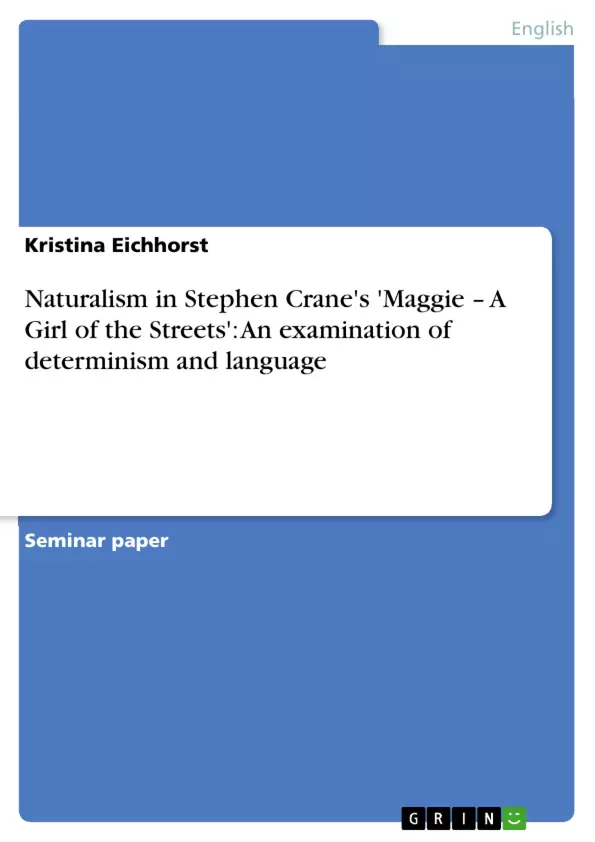When Mark Twain published his Adventures of Huckleberry Finn in 1884, it was seen as the most important representative of a new literary movement: the realistic literature. Though not everyone thought of the novel as a “masterpiece” from the beginning on, it became more popular and significant in the following decades. Ernest Hemingway even called it “the one book that all modern American literature comes from” (Bloom 2004:2). Taken at face value, this statement implies that also Stephen Crane's Maggie – A Girl of the Streets has been influenced by Twain's writing. Since both authors belong to the same period in American literature they naturally adopted literary styles, topics and devices that were typical for that era. Though both novels belong to the realistic period they vary in certain aspects. Unique to Crane's novel are the use of language and the determinism that accompanies the story. These aspects are the central subjects of this paper. It states that language, the characters and the aspect of determinism make Maggie a rather naturalistic than realistic novel. To understand the difference between both terms a review gives the characteristics of realism and separates naturalism as an independent literary form. The two main aspects that make Maggie a naturalistic novel are being examined separately afterwards. Here, the novel itself shall be the main source. At first, determinism is detected in the novel and it shall explain how the characters' fate is shaped throughout the story. Afterwards, aspects of naturalistic language and animal metaphors are examined. The conclusion gives a brief summary of the findings and offers further considerations on the topic and the novel.
Inhaltsverzeichnis (Table of Contents)
- Introduction
- Realism and Naturalism - two different periods?
- The social background - America after the Civil War
- Topics in Realism and Naturalism
- The special field of Naturalism
- Characteristics of literary Naturalism
- Case Study: Maggie - A Girl of the Streets
- Determinism in Maggie
- Animal metaphors and language
- Conclusion
Zielsetzung und Themenschwerpunkte (Objectives and Key Themes)
The main objective of this paper is to analyze the use of language and the theme of determinism in Stephen Crane's Maggie - A Girl of the Streets. The paper argues that these aspects contribute to the novel being categorized as naturalistic rather than realistic literature. The paper explores the distinct characteristics of realism and naturalism and examines how they are applied in Maggie.
- Realism and Naturalism as literary movements
- The social and historical context of American literature after the Civil War
- Determinism as a key feature in Maggie
- The use of language and animal metaphors in Maggie
- Naturalism as a distinct literary form
Zusammenfassung der Kapitel (Chapter Summaries)
The introduction discusses the context of Stephen Crane's Maggie in relation to the emergence of realism and naturalism in American literature. It highlights the influence of Mark Twain's Adventures of Huckleberry Finn and outlines the key aspects of the novel that make it more naturalistic than realistic.
The second chapter explores the differences between realism and naturalism as literary movements. It delves into the historical and social context of post-Civil War America, explaining how the period of change and upheaval influenced the development of both literary forms. The chapter further discusses the unique characteristics of naturalism, setting the stage for the analysis of Maggie.
The third chapter focuses on the case study of Maggie itself. It examines the concept of determinism in the novel, exploring how the characters' fates are shaped by external forces. The chapter then analyzes the use of language and animal metaphors, demonstrating how these elements contribute to the naturalistic portrayal of Maggie and her environment.
Schlüsselwörter (Keywords)
This paper focuses on the key themes of Realism, Naturalism, determinism, language, and animal metaphors. It examines Stephen Crane's Maggie - A Girl of the Streets as a prime example of naturalistic literature, highlighting the novel's use of language and character portrayal to depict the harsh realities of poverty and social injustice in post-Civil War America.
- Quote paper
- Kristina Eichhorst (Author), 2011, Naturalism in Stephen Crane's 'Maggie – A Girl of the Streets': An examination of determinism and language, Munich, GRIN Verlag, https://www.grin.com/document/188404



